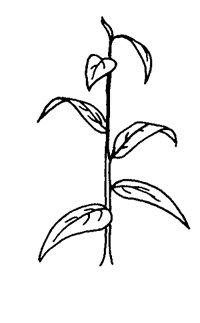Azolla Lam.
pond fern, mosquito fern, water velvet
Azollaceae
not likely to be confused with any other plant genus
cosmopolitancosmopolitan:
(adj) essentially worldwide in distribution
in warmer regions of the world
Azolla caroliniana Willd.
A. filiculoides Lam.
A. mexicana Schlecht. & Cham. ex K. Presl.
A. nilotica Mett.
A. pinnata R. Br.
U.S. Federal Noxious Weed: Azolla pinnata
Identification: Diagnostic characters: vegetativevegetative:
(adj) (1) pertaining to or to the growth of plant organs or plant parts that have nonreproductive functions, such as leaves, roots, stems, etc.; (2) concering non sexual propagules such as tubers, turions, stem fragments, root crowns, rhizomes
: triangular shape of plants, feathery appearance of roots; sexual: megasporangium has 9 floats; microsporangial massulaemassula:
(n) (pl. massulae) in Azolla, a mucilaginous group of microspores within the microsporangium
have no glochidiaglochidium:
(n) (pl. glochidia) a hair-like process bearing an anchor-like tip, that projects from the surface of microsporangial massulae in the Salviniaceae, but have vacuolatedvacuolated:
(adj) having a vacuole or vacuoles
trichomes.
some species are nearly cosmopolitancosmopolitan:
(adj) essentially worldwide in distribution
Azolla pinnata is considered one of the world’s most troublesome weeds and it is an aquatic weed on the U.S. federal noxious weed list.
small, free-floating, with tiny, crowded, bilobed leaves
Annual or perennialperennial:
(adj) (of a plant) having a life cycle of more than two years
water fern. Stem floating, more or less pinnately branched. Roots simple, with root hairs present or absent at nodes. Leaves in two alternatealternate:
(adj) (of leaves) bearing one leaf per node; placed singly on the stem at different heights
 rows, overlapping and covering stem, divided into two lobes; upper lobe aerial, thickened and photosynthetic (red or green colored), lower lobe submersedsubmersed:
rows, overlapping and covering stem, divided into two lobes; upper lobe aerial, thickened and photosynthetic (red or green colored), lower lobe submersedsubmersed:
see submerged
and non pigmented. A thin-walled pouch forms on the upper lobe, enclosing cavities containing nitrogen fixing cyanobacteria (Anabaena azollae Strasb.). Sporocarps borne in pairs in leaf axils of older branches; megasporocarps small, containing a single megasporemegaspore:
(n) in plants that produce two different kinds of spores, the larger of the two types, which develops into the female gametophyte
; microsporocarps with many microsporangiamicrosporangium:
(n) (pl. microsporangia) a saclike structure that produces microspores
 . Dispersal by spores or stem fragments.
. Dispersal by spores or stem fragments.
still waters of all types of water bodies
The genus Azolla comprises seven species of small-leaved floating ferns, some of the cultivated species are currently taxonomically unresolved. Azolla species form a symbiotic relationship with the cyanobacteria Anabaena azollae, which fixes nitrogen and grows in a cavity in the dorsaldorsal:
(adj) (1) of the back of an organ or the side turned away from the axis (syn. abaxial) (compare ventral); (2) in thallose plants (e.g. liverworts); of the upper surface
lobe of the fern's leaves.